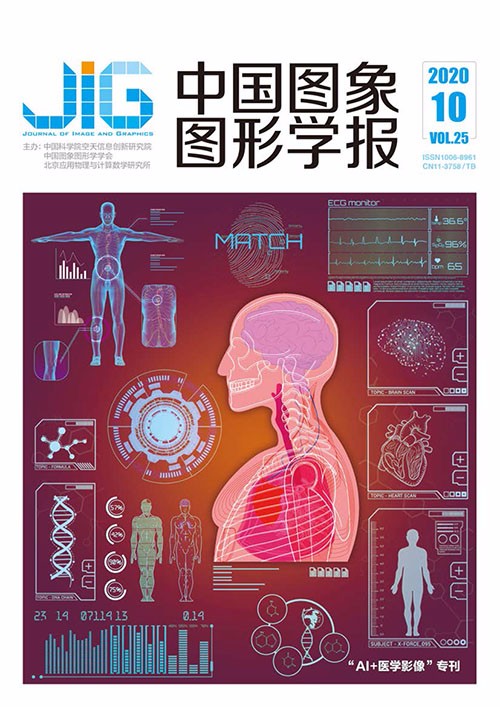
组卷积轻量级脑肿瘤分割网络
摘 要
目的 脑肿瘤是一种严重威胁人类健康的疾病。利用计算机辅助诊断进行脑肿瘤分割对于患者的预后和治疗具有重要的临床意义。3D卷积神经网络因具有空间特征提取充分、分割效果好等优点,广泛应用于脑肿瘤分割领域。但由于其存在显存占用量巨大、对硬件资源要求较高等问题,通常需要在网络结构中做出折衷,以牺牲精度或训练速度的方式来适应给定的内存预算。基于以上问题,提出一种轻量级分割算法。方法 使用组卷积来代替常规卷积以显著降低显存占用,并通过多纤单元与通道混合单元增强各组间信息交流。为充分利用多显卡协同计算的优势,使用跨卡同步批量归一化以缓解3D卷积神经网络因批量值过小所导致的训练效果差等问题。最后提出一种加权混合损失函数,提高分割准确性的同时加快模型收敛速度。结果 使用脑肿瘤公开数据集BraTS2018进行测试,本文算法在肿瘤整体区、肿瘤核心区和肿瘤增强区的平均Dice值分别可达90.67%、85.06%和80.41%,参数量和计算量分别为3.2 M和20.51 G,与当前脑肿瘤分割最优算法相比,其精度分别仅相差0.01%、0.96%和1.32%,但在参数量和计算量方面分别降低至对比算法的1/12和1/73。结论 本文算法通过加权混合损失函数来提高稀疏类分类错误对模型的惩罚,有效平衡不同分割难度类别的训练强度,本文算法可在保持较高精度的同时显著降低计算消耗,为临床医师进行脑肿瘤分割提供有力参考。
关键词
Lightweight brain tumor segmentation algorithm based on a group convolutional neural network
Zhao Yiming, Li Qiang, Guan Xin(School of Microelectronics, Tianjin University, Tianjin 300072, China) Abstract
Objective Brain tumor is a serious threat to human health. The invasive growth of brain tumor, when it occupies a certain space in the skull, will lead to increased intracranial pressure and compression of brain tissue, which will damage the central nerve and even threaten the patient's life. Therefore, effective brain tumor diagnosis and timely treatment are of great significance to improving the patient's quality of life and prolonging the patient's life. Computer-assisted segmentation of brain tumor is necessary for the prognosis and treatment of patients. However, although brain-related research has made great progress, automatic identification of the contour information of tumor and effective segmentation of each subregion in MRI(magnetic resonance imaging) remain difficult due to the highly heterogeneous appearance, random location, and large difference in the number of voxels in each subregion of the tumor and the high degree of gray-scale similarity between the tumor tissue and neighboring normal brain tissue. Since 2012, with the development of deep learning and the improvement of related hardware performance, segmentation methods based on neural networks have gradually become the mainstream. In particular, 3D convolutional neural networks are widely used in the field of brain tumor segmentation because of their advantages of sufficient spatial feature extraction and high segmentation effect. Nonetheless, their large memory consumption and high requirements on hardware resources usually require making a compromise in the network structure that adapts to the given memory budget at the expense of accuracy or training speed. To address such problems, we propose a lightweight segmentation algorithm in this paper. Method First, group convolution was used to replace conventional convolution for significantly reducing the parameters and improving segmentation accuracy because memory consumption is negatively correlated with batch size. A large batch size usually means enhanced convergence stability and training effect in 3D convolutional neural networks. Then, multifiber and channel shuffle units were used to enhance the information fusion among the groups and compensate for the poor communication caused by group convolution. Synchronized cross-GPU batch normalization was used to alleviate the poor training performance of 3D convolutional neural networks due to the small batch size and utilize the advantages of multigraphics collaborative computing. Aiming at the case in which the subregions have different difficulties in segmentation, a weighted mixed-loss function consisting of Dice and Jaccard losses was proposed to improve the segmentation accuracy of the subregions that are difficult to segment under the premise of maintaining the high precision of the easily segmented subregions and accelerate the model convergence speed. One of the most challenging parts of the task is to distinguish between small blood vessels in the tumor core and enhanced-tumor areas. This process is particularly difficult for the labels that may not have enhanced tumor at all. If neither the ground truth nor the prediction has an enhanced area, the Dice score of the enhancement area is 1. Conversely, in patients who did not have enhanced tumors in the ground truth, only a single false-positive voxel would result in a Dice score of 0. Hence, we postprocessed the prediction results, that is, we set a threshold for the number of voxels in the tumor-enhanced area. When the number of voxels in the tumor-enhanced area is less than the threshold, these voxels would be merged into the tumor core area, thereby improving the Dice score of the tumor-enhanced and tumor core areas. Result To verify the overall performance of the algorithm, we first conducted a fivefold cross-validation evaluation on the training set of the public brain tumor dataset BraTS2018. The average Dice scores of the proposed algorithm in the entire tumor, tumor core, and enhanced tumor areas can reach 89.52%, 82.74%, and 77.19%, respectively. For fairness, an experiment was also conducted on the BraTS2018 validation set. We used the trained network to segment the unlabeled samples for prediction, converted them into the corresponding format, and uploaded them to the BraTS online server. The segmentation results were provided by the server after calculation and analysis. The proposed algorithm achieves average Dice scores of 90.67%, 85.06%, and 80.41%. The parameters and floating point operations are 3.2 M and 20.51 G, respectively. Compared with the classic 3D U-Net, our algorithm shows higher average Dice scores by 2.14%, 13.29%, and 4.45%. Moreover, the parameters and floating point operations are reduced by 5 and 81 times, respectively. Compared with the state-of-the-art approach that won the first place in the 2018 Multimodal Brain Tumor Segmentation Challenge, the average Dice scores are reduced by only 0.01%, 0.96%, and 1.32%. Nevertheless, the parameters and floating point operations are reduced by 12 and 73 times, respectively, indicating a more practical value. Conclusion Aiming at the problems of large memory consumption and slow segmentation speed in the field of computer-aided brain tumor segmentation, an algorithm combining group convolution and channel shuffle unit is proposed. The punishment intensity of sparse class classification error to model is improved using the weighted mixed loss function to balance the training intensity of different segmentation difficulty categories effectively. The experimental results show that the algorithm can significantly reduce the computational cost while maintaining high accuracy and provide a powerful reference for clinicians in brain tumor segmentation.
Keywords
magnetic resonance imaging(MRI) brain tumor segmentation deep learning group convolution weighted mixed loss function
|



 中国图象图形学报 │ 京ICP备05080539号-4 │ 本系统由
中国图象图形学报 │ 京ICP备05080539号-4 │ 本系统由